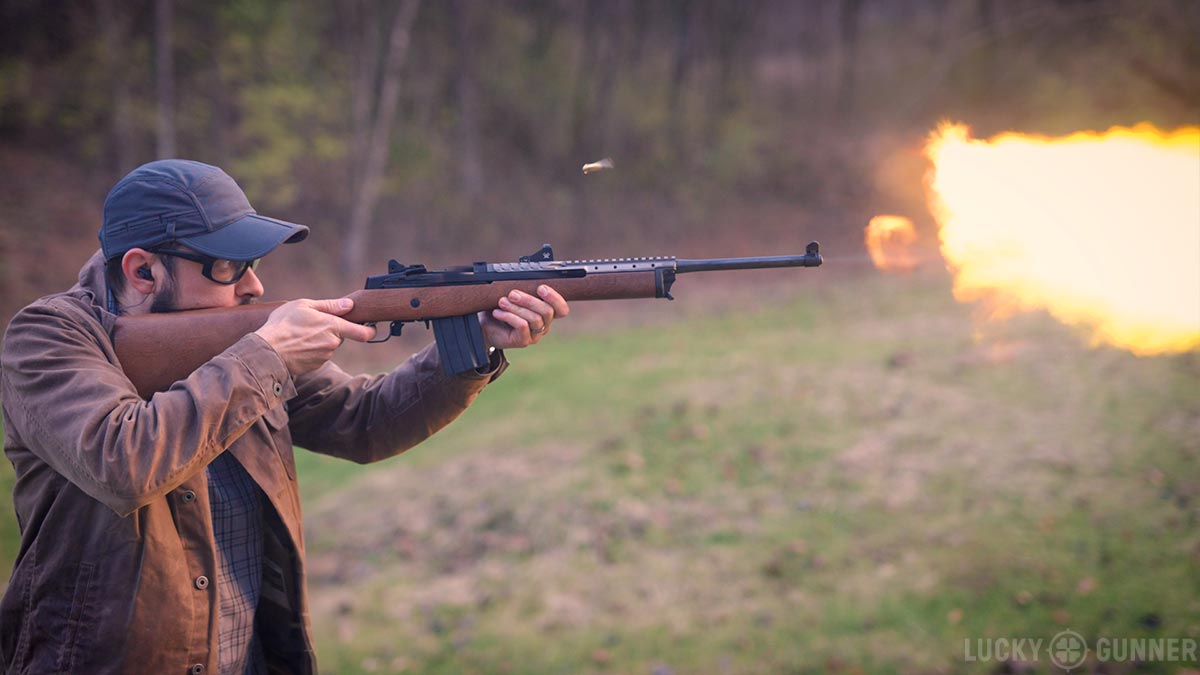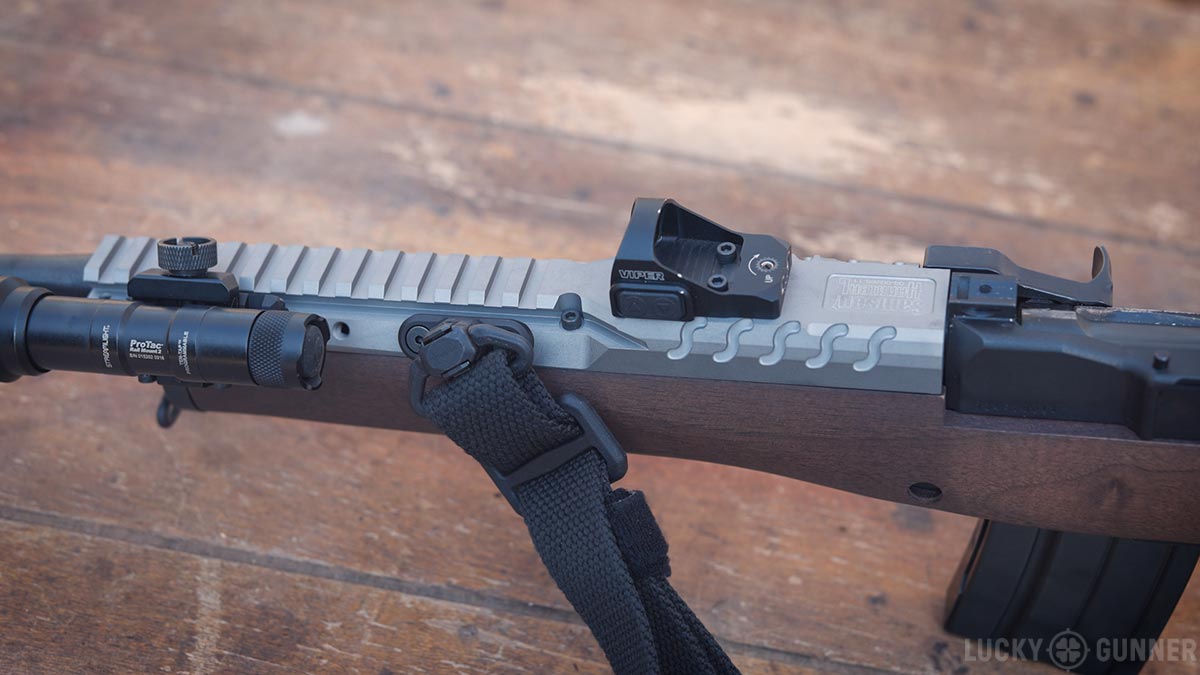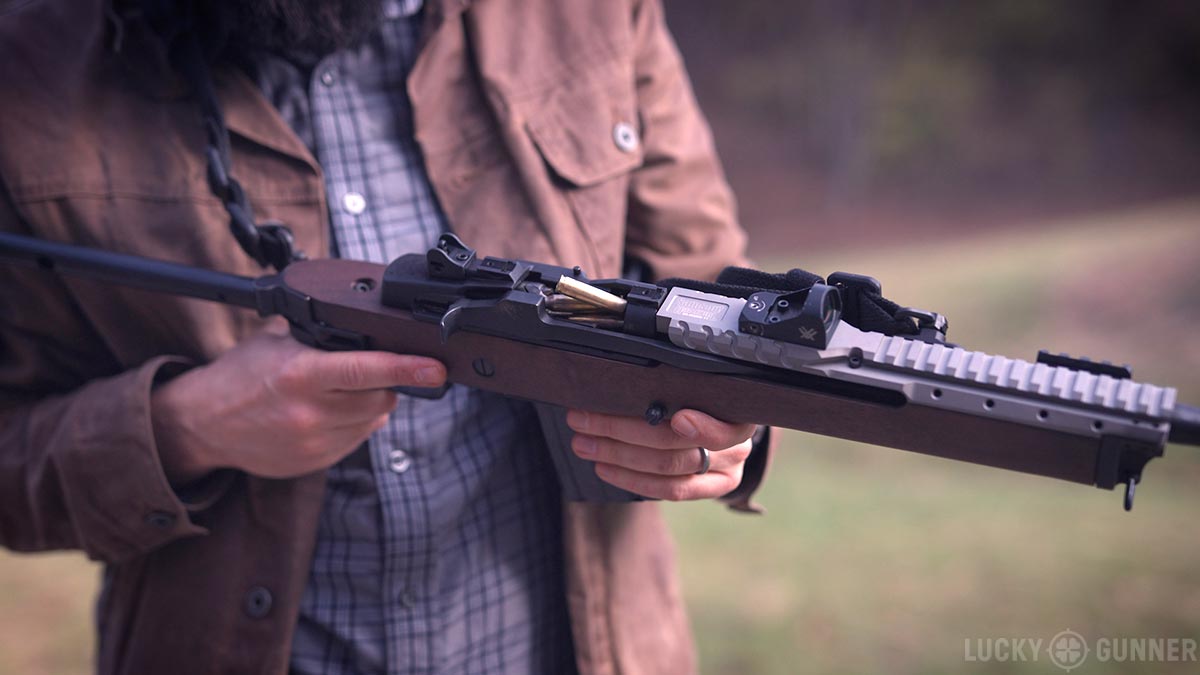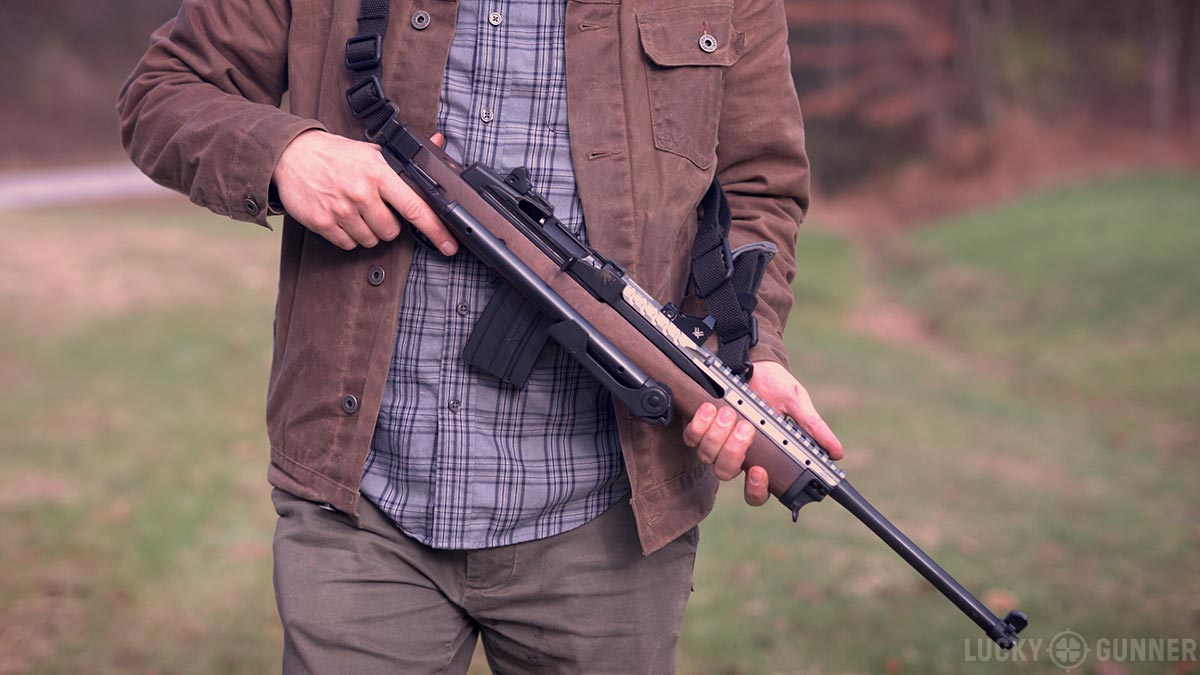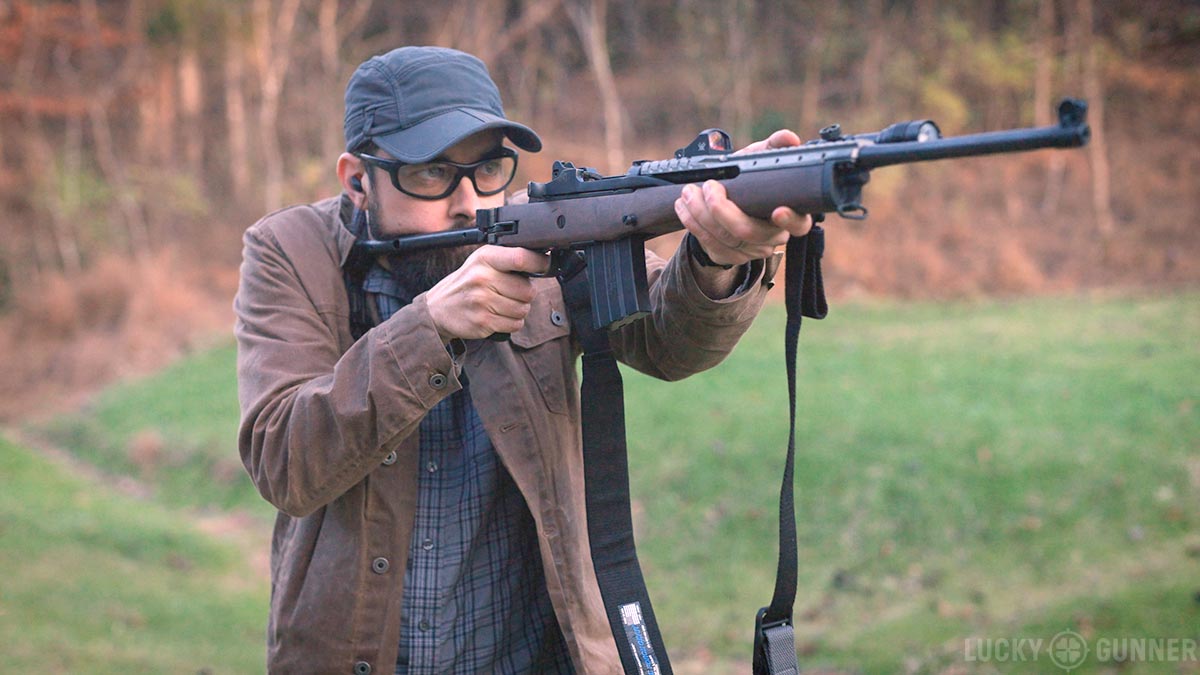Despite all the criticism, the Ruger Mini-14 is still around for the same reason any gun has a long production run — people keep buying it. Last time, we looked at the Mini’s history and why it became popular to begin with. In part 2, we’re looking at why it’s still popular today in a market with plethora of affordable alternatives. We also share our first hand experience with some of the Mini-14s more notorious flaws.
Details are in the video below, or scroll down to read the transcript.
Against all odds, the Ruger Mini-14 refuses to die. It’s dated and expensive. But it’s still in production today and it remains popular with a lot of shooters.
In part one, we looked at the history of this rifle, and we ended with the question, “what can the Mini-14 do that a scary black rifle cannot?” The answer is – not much, really. At least not from a purely functional perspective. It’s less versatile, less accurate, and less reliable than a halfway decent AR-15. The advantages of the Mini-14 are mostly intangible. If you’re buying a Mini today, it’s probably for one of two reasons: legality or aesthetics.
A 50-State Legal Rifle
There are a few states – I believe we’re up to seven or eight – where AR-15s and similar rifles are either banned or restricted. Most of these laws try to regulate guns based on certain features like pistol grips and adjustable stocks. The basic Mini-14 without the flash hider doesn’t have any of the banned features, so it’s still legal in all 50 states. For now. I think. Don’t take my word for that.
There are also magazine capacity limits in those states, so in most cases, you’re stuck with 10-round mags. Considering the other options available in the ban states, a Mini-14 is a decent rifle. You can make it work. There are shooters in California, for example, who probably know more than anyone else about how to tweak and optimize the Mini to get the most out of it because that’s what they’ve had to work with for years now. The ban state sales alone could probably keep the Mini-14 in production for a long time. But that’s not the only reason people like the Mini.
Aesthetic Appeal
Outside of the ban states, aesthetics is probably the driving factor behind most Mini-14 sales today. And by aesthetics, I don’t just mean that people like the way the gun looks, although that’s a big part of it for some. It evokes nostalgia for WWII-era rifles, or maybe for corny action TV series from the 80s.
The main aesthetic appeal is that it’s not an AR-15. I could list dozens of reasons why the Mini is functionally inferior to a quality AR – and we’re going to talk about some of those in a minute. But the fact that it’s not an AR is exactly why a lot of people are drawn to it.
Maybe they’re bored with ARs and they just want to add something different to their collection. Others are concerned about how an AR-15 will be perceived if they ever have to use it in self-defense. The Mini-14 doesn’t have the same image problem among the general public.
Even among gun owners, there are some negative stereotypes associated with the AR-15. I’ve noticed this especially with newer shooters, or shooters who don’t personally know many people who own ARs. They associate the AR with guys who try to look like combat veterans and call everybody “brother,” or the high-end gear snobs, or the people who don’t really shoot, but they buy an AR solely to make a political statement.
I think it’s easy for people who don’t have a ton of experience with the rifle itself to feel like buying an AR would mean they’re joining one of these stereotypes. For those people, the Mini-14 is the anti-tactical rifle that can still do tactical kind of things if they want it to.
Challenging the “Just as Good” Mantra
It should be no surprise to any of our regular viewers that I appreciate the desire to just be a regular person who owns guns rather than embrace the so-called “armed lifestyle” that comes with a predetermined wardrobe and personality.
The trouble is, if you expect a Mini-14 to perform like an AR except with a friendly-looking wood stock, you’re likely to be disappointed.
The Mini has a bunch of what I would call minor shortcomings that I could personally overlook if it wasn’t for the bigger shortcomings.
The magazines seem expensive, but only because we’re used to dirt cheap AR mags. The 20-round factory mags cost about the same as what I pay for most pistol magazines.
Mounting optics is not as much of a chore as it used to be. A few companies like Ultimak and Amega make optic rails that replace the factory handguard. The rail we have on this rifle is the Hannibal Rail from Samson Manufacturing. We couldn’t find a black rail in stock anywhere, but this gray version would go really well with a stainless Mini.
It has a flat section in the rear which gives you the option to direct-mount a micro red dot. That positions the optic nice and low so you get a full cheek weld and, depending on the optic, a co-witness with the iron sights. It also has places to mount accessories like a QD sling swivel and a white light – that covers another couple of common nitpicks with this rifle.
I’m not aware of any way to improve the manual safety. It’s in a less than ideal place and it invites you to put your finger in the trigger guard before it should be in there. But even that is something I could learn to live with. There are two bigger issues that really make the Mini-14 hard to embrace for anything other than a range toy. They’re the two I mentioned at the beginning: accuracy and reliability.
Accuracy and Reliability
This is a brand new Mini-14 that we bought just a few weeks ago. We haven’t done anything to it except try a couple of different stocks and add this optic rail. No modifications to the action or the trigger or anything internal.
We’ve run about 700 rounds through the gun – it was lubed several times and cleaned once about halfway through. It had numerous stoppages during our testing, regardless of which stock we were using or whether the rail was mounted. Nothing really serious like a parts breakage. But about half a dozen times, the bolt locked open while there were still rounds in the magazine. On a couple of occasions, the bolt cycled, but failed to pick up a round from the mag, so I got a click when I pulled the trigger. And I had one ugly failure to eject.
That comes down to roughly one malfunction for every 70 rounds fired, and that’s just not up to par for a modern semi-automatic rifle.
Based on the feedback we got from part 1, this kind of experience is not unique. Some of you said you like your Mini because it *is* reliable, but we heard from just as many people who sold or just stopped shooting their Minis because they couldn’t get them to run.
The Mini-14’s problems with accuracy are almost legendary. The newer rifles are, on average, more accurate than those made before the mid-2000s. But accuracy is still an issue, and it seems to be inconsistent from one gun to the next.
We tried a few different match grade loads through this rifle at 100 yards. The best groups came from the Winchester USA Ready 62-grain Open Tip – 2.2 and 2.7 inches. But the other two groups we fired with that same load were 6 and 6.7 inches. With every load, most groups had one or two fliers. There was just no way to predict what the gun was going to do.
I don’t think I’m holding this gun to an unrealistic standard. Most of us don’t need sub-MOA accuracy for most of the things we’re going to do with a rifle. 2-3 MOA will probably get the job done. But 6-7 MOA is just bad.
I’ve heard people dismiss the accuracy problem by saying that the average shooter is not as accurate as the gun anyway, so it doesn’t matter. That argument has never made any sense to me. An inaccurate rifle is not canceled out by mediocre shooting. If a shooter is capable of 6 MOA accuracy and you give him a gun that’s capable of 6 MOA, he’s now a 12 MOA shooter. He’s twice as bad.
I could walk into any gun store – at least, outside of the ban states – and choose, at random, any other new rifle chambered for 5.56 and it is almost guaranteed to be capable of better than 6 MOA accuracy – especially if that rifle cost as much as this Mini-14. If you need to use your rifle for anything practical at all, or if you just enjoy hitting what you aim at, it’s really hard to justify a 6 MOA $1000 rifle in the year 2022.
Objective Advantages
I want to give credit where it’s due, so there is at least one area where the Mini-14 is objectively better than the AR-15 and that’s the lack of a buffer tube. That provides a couple of advantages.
The first is a lack of mechanical offset. The buffer tube places the AR’s stock in a direct line with the bore. That means the sights or optic have to be an inch or two higher so they’re in line with your eye. This isn’t really a problem except at close range. Out to about 15 yards, your point of impact can be significantly lower than your point of aim – about two inches, give or take a half inch. Like most traditional wood stocks, the comb of the Mini-14 stock is slightly below the bore line, so the sights are right on top of the barrel. There is still a little offset, but it’s pretty negligible.
A couple of inches of offset doesn’t make much of a difference if I’m aiming for something like the middle of this IPSC target. Even if I don’t compensate for the mechanical offset, I’ll get good hits. It’s more of an issue if I’m going for a smaller target like the head box. But even then, I’m on the target, just a little low.
Where offset tends to become a real problem is when shooting around cover or obstacles. If I fire right now, I’m going to hit this barricade, but when I look through the optic, I don’t see any obstruction. You have to train consistently in order to remember to compensate for offset. It’s easy to learn but hard to remember. That’s a much smaller issue with guns like bolt actions, lever actions, shotguns, or the Mini-14.
The other perk to not having a buffer tube is that you can have a folding stock like this one, which is also from Samson Manufacturing. This is the A-TM folding stock. Except for a couple of minor improvements, it’s a perfect replica of the Ruger factory folding stock from the 80s.
There’s a release here that lets the stock swing over. Then you press the lock button on the back to fold in the buttplate, which clips onto this stud on the side of the stock. That keeps it locked in the folded position. You can fire with the gun folded if you want. Or just press the lock button again and swing it back into the open position.
The stock is surprisingly comfortable to use. The cheek weld is decent. It’s got a 13.5-inch length of pull, which I find to be a little on the long side, but that’s the same as the Ruger wood factory stock. I tried firing from some awkward positions with the V-Tac barricade and it was a little tougher than using the traditional stock, but not horrible. For normal shooting positions, it’s not bad at all.
With the stock folded, the overall length is 27.5 inches. That’s with an 18.5-inch barrel. The Mini with the 16.5-inch barrel and a flash hider would be about an inch shorter. So we’re not looking at a backpack-sized gun here. But the folding stock makes it a little easier to store, or maneuver around inside your battle van.
Of course, there are other rifles with folding stocks if that feature is important to you. It’s always been an option for AKs. Now we even have ARs with folding buffer tubes and several AR-style carbines with no buffer tube at all. So this really just comes back to aesthetics. The main appeal here is the cool factor.
The Mini-14 Lives
As a huge fan of the M1 Carbine, you might think that I’d also be fond of the Mini-14. They have a lot of similar qualities, including some of the same flaws. But the M1 Carbine is more than a pound and a half lighter. It’s a little softer shooting, it’s not as loud, and it’s slightly more accurate.
And I don’t hold the M1 Carbine to the same standard as the Ruger, anyway. If I owned a vintage muscle car, I wouldn’t expect it to have the same gas mileage or reliability as a modern daily driver. I don’t think the Mini-14 makes a very good daily driver. If you need a rifle that can be used for personal protection or hunting or competition, the Mini-14 leaves a lot to be desired.
But it doesn’t matter what I think. The Mini-14 is far from dead and it doesn’t look like it’s going to die anytime soon. A lot of people really like this gun. Some have had to learn to like it because they don’t have many other options. Others like it for reasons that defy logic and practicality. Like I always say, as long as you can use it safely and you understand its limitations, buy the gun you wanna buy and have fun.
Guys, I hope you have enjoyed this two-part series on the Ruger Mini-14. A big thanks to all of you who hit that like button and subscribe to our channel. And an extra huge thank you to our customers. I don’t know where the rest of you are getting your ammo, but I pity the fool who doesn’t buy it from us with lightning fast shipping at LuckyGunner.com.
The post Why Won’t the Ruger Mini-14 Just Die? [Part 2] appeared first on Lucky Gunner Lounge.


